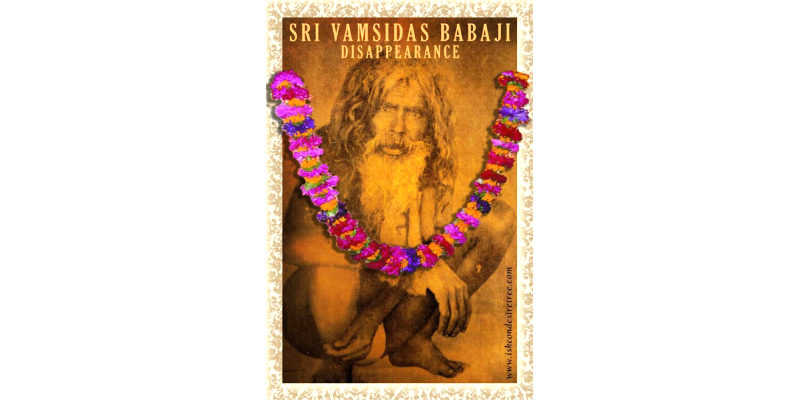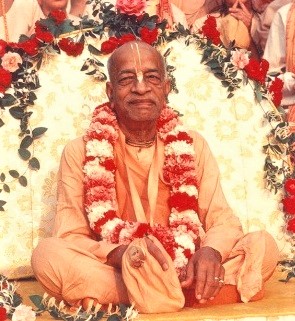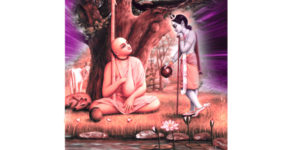Srila Vamsidasa Babaji appeared in this world in 1859 in the village of Majitpur, which was at that time part of the Mymensingh District of East Bengal, British India. It is now located in the Pakundia police station in the Kishorganj District of present-day Bangladesh.
Three Bäbäjés of Navadvépa—Çréla Jagannätha däsa Bäbäjé, Çréla Gaura-Kiçora däsa Bäbäjé, and Çréla Vaàsédäsa Bäbäjé—were all absorbed in deep devotion to Kåñëa. For a reluctant student, a disciplined atmosphere is necessary to see him through his course. However, an eager student does not need inducement or pressure to open his books. Similarly, rules and regulations are required for those who have not developed a spontaneous taste for devotional service. For devotees who have already attained the elevated stage of advanced devotion, rules and regulations serve no meaningful purpose.
Srila Vamsidasa Babaji was a topmost paramahaàsa devotee. His character and behaviour were not easy to understand. Even reading about him may not help much in comprehending him. We should not misunderstand and make erroneous judgements based on limited experience.
The behaviour of Vamsidasa was so unusual that only the most advanced devotees, those on the same level of perfection, could clearly recognise his greatness. Had Bhaktivinoda Öhäkura and Bhaktisiddanta Sarasvaté Öhäkura not informed us of the actual position of Vaàsédäsa Bäbäjé Mahäräja, his transcendentally ecstatic behaviour would probably be misunderstood. Bäbäjé never associated with such misunderstanding deviants, but rather he decried their activities.
His father was Sanätana Mallabrahma, a poor man from the Barman fisherman caste. His mother, Çrématé Sarvasundaré, a typical pious Hindu woman of the time, was much inclined to fasts, austerities, and vows for the benefit of her family members. Their first son, Bhairab Chandra, was later to become famous as Vamsidasa Babaji. Two other sons, Kulachandra and Rajachandra, followed, along with four daughters.
As was customary for all caste Hindus, Bhairav Chandra took initiation from his family’s guru, who was from the Narottama Parivara of Jamalpur. Like many of the fishing caste in Bengal even today, Bhairab was brought up in extreme poverty. His family survived from day to day on whatever fish they could catch. Life was rough, devoid of any comforts or niceties, and there was no question of education. Young Bhairab only had to learn how to catch and sell fish.
He would spend his days at the river with his father and other fishermen, but on returning home at sunset, he would make his way to the Gaura-Nitäi temple in the neighbouring village of Jamalpur. There, in the rough village dialect that was the only language he knew, he heard from a Vaiñëava guru, Narottama däsa Bäbäjé of Nigoya, of the temporality of material life, the pastimes of Çré Kåñëa Caitanya Mahäprabhu, and the glories of the holy name.
Then, as now, Bengal’s villages were infested with bogus misrepresenters of Vaiñëavism. Some took Vaiñëavism as a license for debauchery, while others made money out of cheap presentations of kåñëa-lélä. Bhairav was never attracted to such pretenders, but heard carefully from his guru and kept close to his lotus feet.
Gradually, Bhairav started to spend most of the evening hours at the guru’s äçrama. Seeing his growing indifference to worldly affairs, his parents anxiously arranged for his marriage. However, despite acceding to his parent’s plans, Bhairav’s apathy to material life continued to grow. Shortly after marriage, Bhairav left home, abandoning his young wife and six-month-old son to become a sannyäsé.
Paramahaàsa bäbäjés in the Gauòéya-Vaiñëava tradition do not follow any regulations of scripture, neither the worldly ones of the varëäçrama system, nor those meant for spiritual advancement by the process of sädhana-bhakti. Thus they are known as avadhütas, devotees beyond ordinary rules, and their behaviour often appears eccentric to ordinary people.
However, even among avadhüta bäbäjés, the character of Vaàsédäsa was unique. His behaviour was so unusual that in any culture less spiritually enlightened than that of India, he would almost certainly have been considered crazy. Although physically present in this world, he had little connection with it. He was six feet tall and strongly built. His hair and beard were uncut, matted, and he appeared disheveled. He never took bath, and his eyes looked wild. He wore a loincloth only and nothing more.
Çréla Bhaktisiddanta Sarasvaté Öhäkura sometimes visited Vaàsédäsa at his kuöirä in Navadvépa town. Seeing him approaching, Vaàsédäsa would exclaim, “Oh, a maïjaré has come, so won’t Rädhäräëé come also? She will come. She will come!” When visiting Vaàsédäsa, Çréla Bhaktisiddhänta warned his disciples to sit silently and not make any offence, lest they misunderstand his wild appearance and eccentric behaviour.
Vaàsédäsa Bäbäjé mostly stayed in Navadvépa town, in the area of Raniganj. He lived there in a bhajana-kuöirä (a tiny cottage made from mud and thatch) with his Deities of Çré Gaura, Gadädhara, and Nityananda, Çré Çré Rädhä-Govinda, and Bala Gopäla.
Vaàsédäsa’s entire existence revolved around his Deities. He would talk day and night with Them and was hardly aware of anything else. His Deities, some kaupina, and a few odds and ends were his only possessions.
Vaàsédäsa was especially attached to his Gopäla Deity, whom he carried everywhere in his right hand. His Rädhä-Govinda Deities were six inches high and made of añöa-dhätu (eight precious metals). His Gaura-Nitäi Deities were three feet high and made of wood.
Vaàsédäsa worshipped the Deities in his own way, with no knowledge of rules and regulations. There was no formal system of worship, no proper routine, no siàhäsana, or any other such arrangement. He simply offered flowers that he collected nearby at midday.
Without mantras, püjä, ringing of bells, or any such thing, he offered food to his Deities just by giving it to Them. Sometimes he fed Them and sometimes he didn’t. Sometimes he cooked and offered fried chickpeas. Sometimes he cooked kicaré. There was no set time, system, or standard. He never put the Deities to sleep, woke Them up, or anything like that.
Vaàsédäsa’s mode of worship was simply to see his Deities, live with Them, and talk with Them in a most intimate and informal manner, sometimes laughing and sometimes quarreling with Them. He hardly spoke to anyone of this world, but would spend all day talking to his beloved Deities, especially Gopäla and Gaura-Nitäi.
On April 5, 1943, Vaàsédäsa came to the western gate of the Jagannätha temple. He remained there in his usual mood of ecstatic emotion. While he was staying at this gate, Çrépäd Bhaktipradipa Tértha Gosvämé, at that time the head of the Gauòéya Mission, came from the Puruñottama Maöha. Bhaktipradipa Tértha Mahäräja and some brahmacärés of the maöha performed saìkértana with mådaìgä and karatalas. After hearing that kértana, Bäbäjé Mahäräja said, tapa tapa hari khol phate buk phatena: “By chanting and meditating the mådaìgä breaks but the heart does not!” When the assembled devotees heard this, they paid their obeisance to the feet of Bäbäjé Mahäräja and, becoming silent, sat down there.
At the time of Ratha-yatra, when the chariot of Lord Jagannätha was passing by the banyan tree where Bäbäjé Mahäräja was camped, it came to a halt for some hours. Despite much struggle, the people could not move the Lord’s chariot. However, after Bäbäjé Mahäräja had some intimate conversations with Lord Jagannätha, the chariot moved again.
One time, Vaàsédäsa heard a boatman who was rowing across the Ganges at Navadvépa and singing a song by Narottama däsa Öhäkura. The song meant, “A spear has entered my heart. It has neither killed me nor can I survive.” There is a deep meaning to this song that compares separation from Kåñëa to be like a spear. When Vaàsédäsa heard the boatman singing this, he admonished him, “You are singing but you do not know what it means. You are simply enjoying singing the song without any realisation. But when we hear this song, our hearts are pierced. You do not know that. You are just singing, but my heart is breaking.”
Some days before leaving this planet, Bäbäjé Mahäräja returned to Majitpur. On July 23, 1944, he left this world. His samädhi is being worshipped there. A large water tank and an old building mark the place where he used to live.
How to Go There
A direct bus service is available from Mahakhali Bus Terminal in Dhaka. Take the Kishoreganj bus and get down directly in front of the gate of the temple, which is a few minutes before Mirjapur stop.
You can see other Holy Places. Click Here







